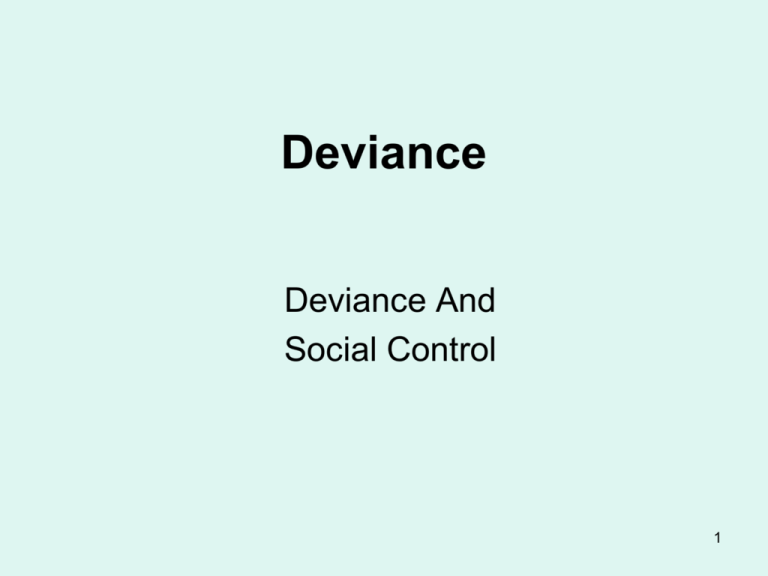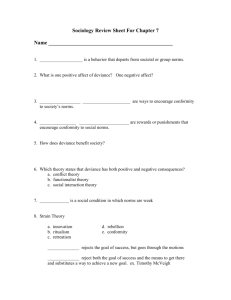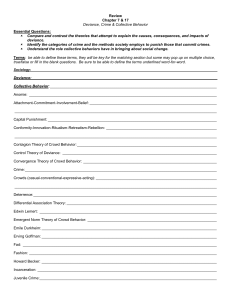Deviance
advertisement

Deviance Deviance And Social Control 1 Deviance Norms allow social order. How we play our roles and how we interact with others? 2 Deviance Why human groups need norms to exist, develop a system of social control? Formal and informal social control? 3 Deviance Some of the sanctions human groups use to enforce norms such as shaming, degredation ceremonies… 4 Deviance Everyone breaks the rules from time to time. Why people break(violate) norms? Biologicalists: Intelligence – Y choromosom – Body type Psychologicolists Personinality disorder – Suffocating mothers Bad toilet training Sociologicalists Social influence–Socialization – Subcultural group membership – education – Occupation - Income 5 Deviance Disapproval of deviance: Negative sanctions Frawns Gossip Imprisonment Capital punishment 6 Deviance Street crime White-collar crime? 7 Deviance How can be deviance rates declined? Is there any recidivist here? 8 Deviance Symbolic Interaction Perspective: A) Association Theory: Family-Neighborhood B) Control Theory: Inner and Outher systems C) Labelling Theory: Some resist being labelling. Denial of responsibility – I did not do it Denial of injury: Who really got hurt Denial of victims: She deserve it Condemnation of condemner: Who you are Appeal to a higher loyalty: I had to help my friend 9 Deviance Fuctionalist Perspective: Deviance clarifies moral boundaries It promotes social unity It promotes social change 10 Deviance Robert Merton - Strain Theory What happens when people are socialized to desire a cultural goal but are denied the institutionalized (legitimate) •Anomie •Strain people 5 reactions: Conformity Innovation Ritualism Retreatism Rebellion According to this theory deviants are the products of 11 their society. Deviance Social clasess crime types? 12 Is it Deviance? • In the following 10 slides, determine if what you see constitutes Deviance. • You may base your decisions on behavior, beliefs, or the condition of the person. Deviance? Deviance? Deviance? Deviance? Deviance? Deviance? Deviance? Deviance? I’m single, I have a career, and I’m happy with my life. Deviance? Deviance? What is Deviance? • Any behavior, belief, or condition that violates significant social norms in the society or group in which it occurs. • Interestingly – one who is considered “deviant” by one category of people may be seen as “conformist” in another group Who Defines Deviance? • Common Sense Thinking – Inherent in certain kinds of behavior or people • Sociologists – Formal property of social situations and structures Variations in Deviance • Time to Time – – • Place to Place – – • Group to Group – – • Degrees of Seriousness – – What Do we want to Know • How is deviance defined and who defines it – Is it the person or the action? • How is deviance distributed in society and how do we know • What causes deviance • How is deviance controlled 27 “Deviance is not a property inherent in certain forms of behavior; it is a property conferred upon these forms by the audiences which directly or indirectly witness them. The critical variable in the study of deviance, then, is the social audience rather than the individual actor”. - Kai T. Erikson (1964) Informal and Formal Social Control • Informal social control: used casually to enforce norms • Formal social control: carried out by authorized agents • Interplay between formal and informal social control can be complicated because we have to balance one source of control against another 29 Law and Society • Some norms are so important to a society that they are formalized into laws • Law: governmental social control • Control theory: our connection to other members of society leads us to systematically conform to society’s norms 30 Defining Deviance • Deviance is the violation of Norms, especially widely held norms • Crime is an action declared illegal by some government or agency – Usually, by a legislative body – Sometimes by administrative actions • Is all deviance criminal ? – Pushing children into fashion shows, sports ? – Subcultures and deviance 31 Defining Deviance • Not all crimes are deviant – – – – – PETA Bullying Speeding Gambling White Collar crime • Non Criminal Deviance – Music preferences – Body piercing – Marrying someone • Your parents disapprove of • Your parents want you to – Being a Geek or a Nerd • Where do “rolling Stops” and other trivial driving violations go? 32 Distribution of Deviance • Crime Rates vs Crime Statistics – Variance in Reporting Issues • To Police • To FBI – By Type of Crime • By nature of offender and victim • Blaming the Victim • Location • Organized Crime • White Collar Crime • Non Criminal Deviance… What do we Know – Not much 33 Explanations of Deviance • Historical non Social-scientific explanations – – – – Patterns of Bumps on head The Devil made me do it Mental issues Bad Seed • Sociological Explanations – Functionalist: • Deviance provides an example of what must be avoided because it is wrong • Some deviance can lead to positive social change 34 Controlling Deviance • Is all deviance controlled? – What choices does society have in controlling deviance? • Internal • External • Who controls Deviance – Under what circumstances some forms of deviance not controlled – What is required to control deviant behavior? • How about deviant thoughts? – Presidential Candidate who admitted “Lusting in his thoughts” • How does the nature of society impact the nature, extent and control of deviance? 35 Explanations of Deviance • Anomie The norms are weak or are in conflict. This is the basis for Strain theory – Social structure limits the abilities of certain groups to satisfy culturally dictated goals and aspirations and means to achieve them. • Cultural goals which are acceptable in our society – Wealth – Power – Status – Material Goods • Acceptable means to achieve them – Education – Jobs – Some talents 36 Explanations of Deviance • Conflict or Strain between goals and means produce "anomie” and possibly a high level of maladaptive behavior due to cultural imbalance between goals and means. • Social structure explains differences in upper and lower class crime rates. – Distribution of legitimate opportunities to achieve wealth through legitimate means. • Since goals are not always achieved, means become valuable in themselves. – Often times, means are placed under severe stress. – Little reward in means alone. • Strain falls on a wide variety of people: – mostly concentrated in lower-classes. – because of differential emphasis placed on ability to attain goals. – Goals "open to all." 37 • Anomie created by disjunction of goals and means causes great discomfort. To overcome sense of anomie, different modes of adaptation are used: Source http://www.indiana.edu/~theory/Kip/Strain.htm#Strain 38 Symbolic Interactionist Theories • Social control or Social Bonding – Doesn’t ask why people are deviant, but why they aren’t. • http:\\faculty.ccc.edu\aberger\It's Not A Crime If I Can't be Caught .pdf – Strong Interpersonal ties often lead to strong commitment to the norms • Cultural Transmission, Differential association and subcultures – Who you associate with – Learned behaviors – Interaction with other groups with other norms 39 White-Collar Crime • White-collar crime: illegal acts committed in the course of business activities, often by affluent, “respectable” people – Corporate crime: any act by a corporation that is punishable by the government – Computer crime: use of high technology to carry out embezzlement or electronic fraud 40 Victimless Crimes • Victimless crime: willing exchange among adults of widely desired, but illegal, goods and services – Supporters of decriminalization are troubled by attempts to legislate moral code for adults – Critics object to notion that these crimes are “victimless” 41 Social Order, Deviance, and Crime • Durkheim’s Theory of Deviance – Nothing inherently deviant or criminal in any act – Society identifies criminals for the sake of social order – When societies experience anomie, social integration is weak and people are free to pursue deviant paths 42 Social Order, Deviance, and Crime • Merton’s Theory of Deviance – Anomie theory of deviance: five basic forms of adaptation to cultural expectations • Conformist • Innovator • Ritualist • Retreatist • Rebel 43 Interpersonal Interaction and Local Context • Cultural transmission: individuals learn criminal behavior by interacting with others • Differential association: process through which exposure to attitudes favorable to criminal acts leads to the violation of rules 44 Interpersonal Interaction and Local Context • Social disorganization theory: attributes increases in crime and deviance to the absence or breakdown of communal relationships and social institutions • Labeling theory: attempts to explain why certain people are viewed as deviants while others engaged in the same behavior are not – Also known as the societal-reaction approach 45 Power and Inequality • Criminal justice system serves the interests of the powerful; protect their own interests and define deviance to suit their own needs • Race and Class – Suspects are treated differently based on their race, ethnicity, and social class – Differential justice: differences in the way social control is exercised over different groups 46 Power and Inequality • Gender – Existing approaches to deviance developed with only men in mind – Society tends to treat women in stereotypical fashion – Cultural views and attitudes toward women influence how they are perceived and labeled – As women take on more active and powerful roles both in the household and in business, gender differences in deviance and crime have 47 narrowed The Criminal Justice System • Based on Adversarial system, Conflict • Only available for crimes, not for non criminal deviance – Religious laws deal with some of the non criminal deviance • Made up of – Courts – Police – Corrections • How else is deviance sanctioned? – Hiring practices – Public Opinion – ? 48






